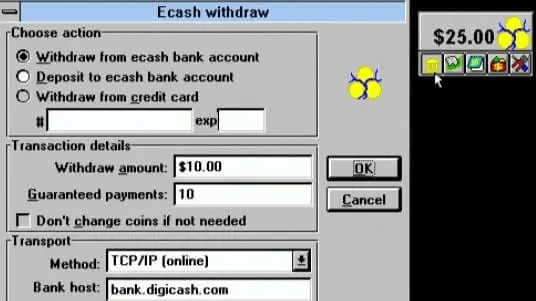The creation of Bitcoin was inspired by various technologies and individuals. For example, Nick Szabo contributed with the concept of “bit gold,” a form of decentralized digital money. Hal Finney developed the Reusable Proof of Work (RPOW), which directly influenced Bitcoin’s proof-of-work mechanism. Additionally, Wei Dai proposed “b-money,” a digital currency idea sharing many characteristics with Bitcoin, while David Chaum introduced foundational concepts like blind signatures and eCash, precursors to anonymous digital transactions.
All these ideas were debated and refined within the cypherpunk community, a group of activists and cryptographers dedicated to developing privacy and digital security projects.
The collaboration and discussions among these visionaries were essential to the formulation of Satoshi Nakamoto’s revolutionary proposal in 2008, which resulted in the creation of Bitcoin.
In this article, you will learn more about David Chaum’s history, understand how he is a central figure in cryptography and digital privacy, and his connection to Bitcoin.
Let’s dive in!
Who is David Chaum?
Born in 1955, David Chaum is an American mathematician and cryptographer who, throughout his career, has been dedicated to developing innovative solutions for internet security, privacy, and value transfer.

He earned a Ph.D. in Computer Science from the University of California, Berkeley, in 1982. In his dissertation, titled “Computer Systems Established, Maintained, and Trusted by Mutually Suspicious Groups,” Chaum laid the groundwork for many of his future projects.
From the beginning, David Chaum recognized the importance of developing systems that would enable secure and anonymous transactions on the internet.
So, let’s explore his main creations:
David Chaum’s Key Creations and Contributions
1. Mix Networks (Anonymous Communication)
Chaum introduced the concept of mix networks in his 1981 paper, “Untraceable Electronic Mail, Return Addresses, and Digital Pseudonyms.”
Mix networks allowed a group of senders to send encrypted messages to a server, where they would be shuffled and re-shuffled, making it difficult to trace the origin and destination of the messages.
This system ensured anonymity in communication and became the foundation for tools like Tor.
2. Trustworthy Voting Systems
Chaum also contributed to secure and verifiable voting systems, including the first proposal in 1981 for a system that allowed end-to-end verification of vote counting while maintaining the privacy of individual votes.
3. Blind Signatures
In 1983, Chaum published a paper titled “Blind Signatures for Untraceable Payments,” introducing the concept of blind signatures.
This technology allows an entity to sign a document without knowing its content, enabling anonymous and secure transactions. This work was fundamental to the development of electronic payment systems.
4. eCash
In 1990, Chaum founded DigiCash Inc., a company that implemented the concept of digital money through eCash, one of the first electronic payment systems to use cryptography to ensure user privacy.
eCash allowed users to transfer digital money securely and anonymously. Thus, participating banks would issue cryptographically encrypted “digital notes” to customers, which could be stored on their personal computers. To make a payment, the customer would send these digital notes to the merchant, who would then forward them to the bank for verification and deposit.
Blind signatures ensured that the bank could not trace the transaction back to the customer, maintaining anonymity.

The first bank to adopt eCash was Mark Twain Bank in St. Louis, Missouri, USA, in 1995. However, despite initial interest and adoption by some banks and merchants, eCash faced several challenges.
At that time, people were hesitant to use credit cards for online purchases of goods and services, and demand for such services was still low. E-commerce only began gaining traction in the latter half of the 1990s.
Additionally, the infrastructure needed to support eCash was complex, and the lack of a wide network of merchants accepting digital currency limited its practical utility.
Despite these adversities, David Chaum received several partnership proposals for DigiCash.
Visa, for example, offered $40 million for the project, and Netscape wanted to integrate eCash into its browser. Even Bill Gates showed interest in including digital currency in all Windows 95 installations.
However, Chaum found Microsoft’s $100 million offer for the technology insufficient. Instead, he countered with a proposal: rather than accepting the offered amount, he requested two dollars for every copy of Windows 95 sold.
This demand made any deal with Microsoft unfeasible.
In 1999, DigiCash closed its doors, marking the end of eCash. Although eCash did not achieve the expected success, it was a pioneering innovation that inspired the development of Bitcoin.
5. Vault Systems
David Chaum’s 1982 dissertation at Berkeley described the fundamentals of blockchain technology, which are used in Bitcoin, except for the proof-of-work mechanism.
His proposed vault system included methods for achieving consensus among nodes, organizing the consensus history into blocks, and timestamping data immutably.
This was in 1982!
6. Other Contributions
In addition to these creations, David Chaum also proposed the anonymous credential system in 1985, contributed to the development of zero-knowledge proofs and commitment schemes in 1988 and 1991, respectively, and introduced important concepts in cryptography and information security throughout his career.
Related article: FediMint: what is this new way to store Bitcoin?
The Legacy of David Chaum and the Emergence of the Cypherpunks
Despite DigiCash’s bankruptcy, David Chaum’s ideas and technologies left a lasting legacy.
Chaum’s pioneering work inspired a community of cryptographers and hackers who gathered in an online forum to discuss and develop new technologies.
This group, which included former DigiCash collaborators and prominent figures like Hal Finney and Nick Szabo, became known as the cypherpunks.
Who Are the Cypherpunks?
The cypherpunks are a community of activists, cryptographers, and hackers who advocate for the use of cryptography as an essential tool to protect privacy and individual freedom in the digital age.
Emerging in the late 1980s and early 1990s, cypherpunks believe that cryptography is crucial for protecting individuals from government and corporate surveillance. They also see it as essential for safeguarding freedom of expression and the security of communications.

The cypherpunks kept the dream of a private and decentralized electronic money system alive.
During the 1990s and early 2000s, they proposed several alternative digital monetary systems, exploring various ways to create secure and anonymous transactions without intermediaries.
Bitcoin emerged directly from these discussions, innovations, and the cypherpunk philosophy.
Inspiration for Bitcoin
In 2008, about ten years after DigiCash’s closure, Satoshi Nakamoto presented a revolutionary proposal for electronic money: Bitcoin.
This new digital currency integrated many of the concepts developed by David Chaum, as well as principles advocated by the cypherpunks, including digital signatures, hash functions, and peer-to-peer networks.
Thus, digital signatures and cryptography, areas pioneered by Chaum, are fundamental components of Bitcoin’s architecture.
Kill Your Heroes!
For those who think David Chaum retired, think again! He remains active and has even attempted to discredit Bitcoin.
In 2018, during a conference in Singapore, he presented the Elixxir project, a cryptocurrency he described as fast, secure, and scalable, and according to him, better than Bitcoin.

Additionally, he also created another project called Praxxis, which he claims is a high-performance digital currency supported by a quantum-resistant blockchain.
The phrase “kill your heroes” holds true and applies well here.
Although David Chaum inspired the creation of Bitcoin, the fact that he developed a currency to compete with it indicates that, despite being an experienced cryptographer and dedicated to user privacy, he didn’t fully grasp the uniqueness and inimitable properties of Bitcoin.
Nevertheless, Chaum’s contributions were significant, and Satoshi brilliantly leveraged the concepts he developed, combining various elements to create a revolutionary idea that continues to transform our financial and technological era.
Did you enjoy the article? Don’t forget to share it with a friend!
Share on your social networks:

Founder of Area Bitcoin, one of the largest Bitcoin education projects in the world, she is a marketer, passionate about technology, and a full-time hands-on professional. She has participated in major Bitcoin conferences such as Adopting Bitcoin, Satsconf, Surfin Bitcoin, and Bitcoin Conference.
Did you like this article? Consider buying us a cup of coffee so that we can keep writing new content! ☕







